Business Report: Critical Analysis of HiTechIndustry's Structure
VerifiedAdded on 2020/02/24
|9
|2088
|610
Report
AI Summary
This business report critically analyzes the organizational structure of HiTechIndustry, a global technology firm. The report, prepared by a management team member, assesses the limitations of the company's traditional hierarchical structure, including message distortion, lack of authority, slow decision-making processes, and inhibition of globalization. It contrasts this with a project organizational structure, advocating for its adoption to foster innovation and efficiency. The report details the advantages of the project-based model, such as faster decision-making, specialization, and avoidance of work repetition. The analysis includes a comparison of the two structures, a review of the literature, and a recommendation for HiTechIndustry to transition to a project-based organizational framework to improve its overall performance and maintain its competitive edge in the global market.
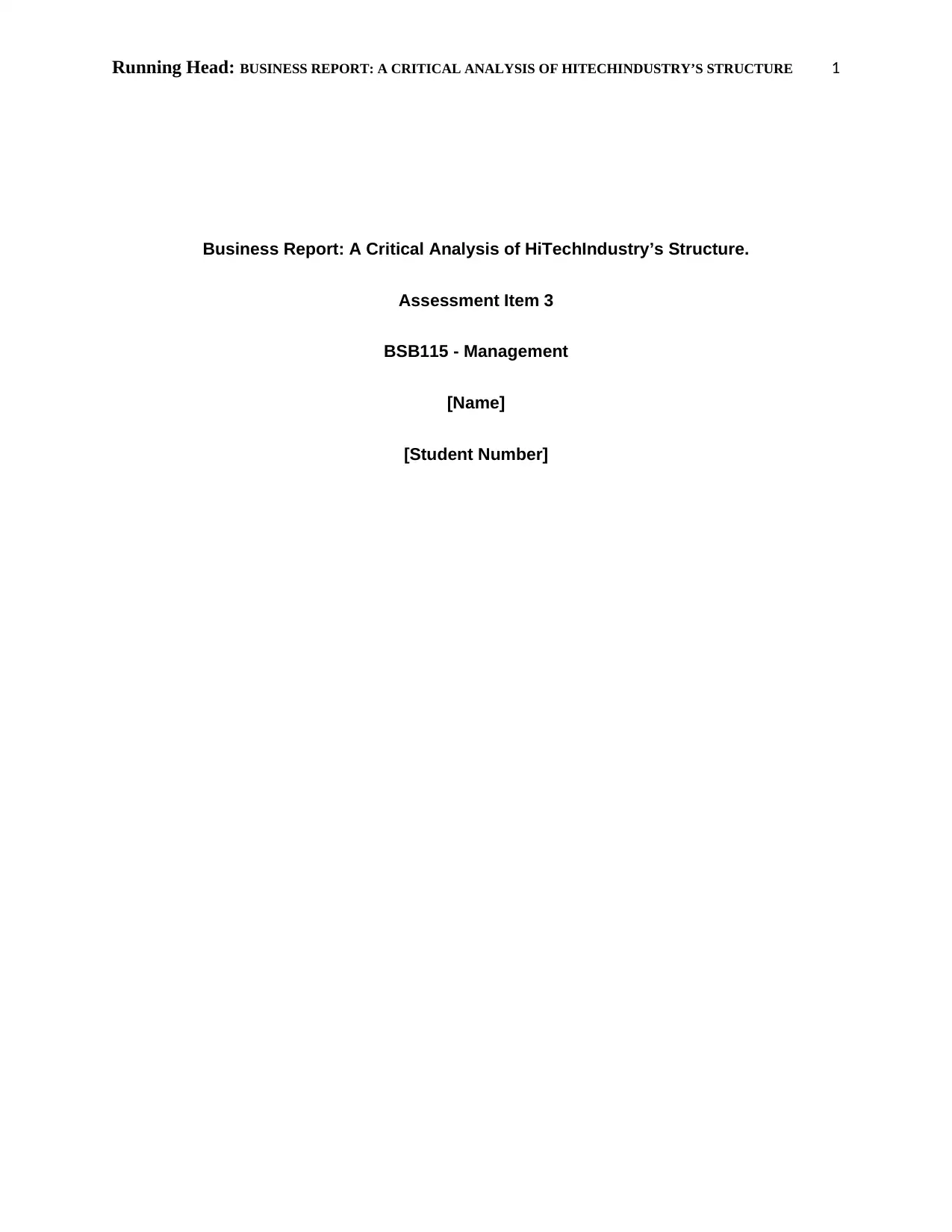
Running Head: BUSINESS REPORT: A CRITICAL ANALYSIS OF HITECHINDUSTRY’S STRUCTURE 1
Business Report: A Critical Analysis of HiTechIndustry’s Structure.
Assessment Item 3
BSB115 - Management
[Name]
[Student Number]
Business Report: A Critical Analysis of HiTechIndustry’s Structure.
Assessment Item 3
BSB115 - Management
[Name]
[Student Number]
Paraphrase This Document
Need a fresh take? Get an instant paraphrase of this document with our AI Paraphraser
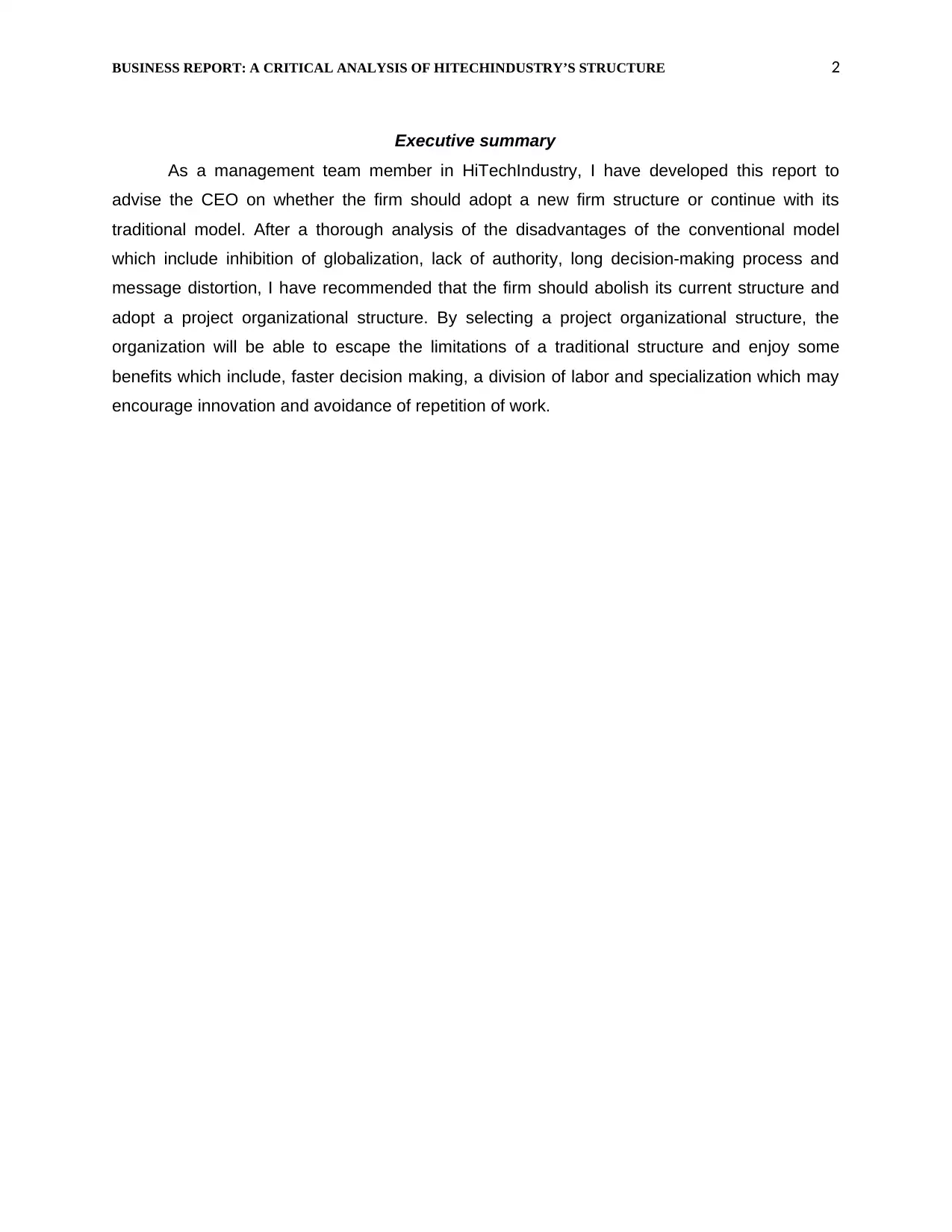
BUSINESS REPORT: A CRITICAL ANALYSIS OF HITECHINDUSTRY’S STRUCTURE 2
Executive summary
As a management team member in HiTechIndustry, I have developed this report to
advise the CEO on whether the firm should adopt a new firm structure or continue with its
traditional model. After a thorough analysis of the disadvantages of the conventional model
which include inhibition of globalization, lack of authority, long decision-making process and
message distortion, I have recommended that the firm should abolish its current structure and
adopt a project organizational structure. By selecting a project organizational structure, the
organization will be able to escape the limitations of a traditional structure and enjoy some
benefits which include, faster decision making, a division of labor and specialization which may
encourage innovation and avoidance of repetition of work.
Executive summary
As a management team member in HiTechIndustry, I have developed this report to
advise the CEO on whether the firm should adopt a new firm structure or continue with its
traditional model. After a thorough analysis of the disadvantages of the conventional model
which include inhibition of globalization, lack of authority, long decision-making process and
message distortion, I have recommended that the firm should abolish its current structure and
adopt a project organizational structure. By selecting a project organizational structure, the
organization will be able to escape the limitations of a traditional structure and enjoy some
benefits which include, faster decision making, a division of labor and specialization which may
encourage innovation and avoidance of repetition of work.
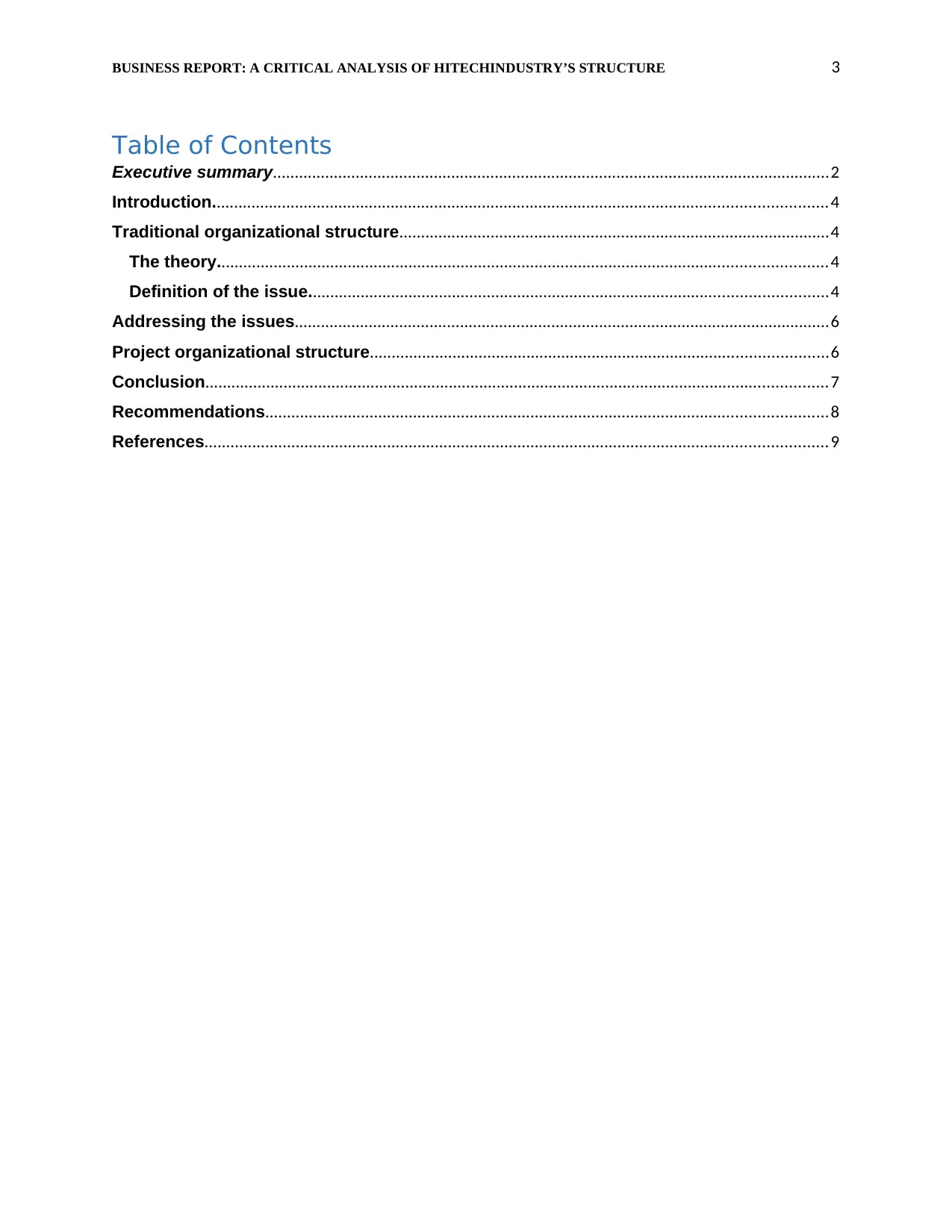
BUSINESS REPORT: A CRITICAL ANALYSIS OF HITECHINDUSTRY’S STRUCTURE 3
Table of Contents
Executive summary................................................................................................................................2
Introduction.............................................................................................................................................4
Traditional organizational structure...................................................................................................4
The theory............................................................................................................................................4
Definition of the issue.......................................................................................................................4
Addressing the issues...........................................................................................................................6
Project organizational structure.........................................................................................................6
Conclusion...............................................................................................................................................7
Recommendations.................................................................................................................................8
References...............................................................................................................................................9
Table of Contents
Executive summary................................................................................................................................2
Introduction.............................................................................................................................................4
Traditional organizational structure...................................................................................................4
The theory............................................................................................................................................4
Definition of the issue.......................................................................................................................4
Addressing the issues...........................................................................................................................6
Project organizational structure.........................................................................................................6
Conclusion...............................................................................................................................................7
Recommendations.................................................................................................................................8
References...............................................................................................................................................9
⊘ This is a preview!⊘
Do you want full access?
Subscribe today to unlock all pages.

Trusted by 1+ million students worldwide
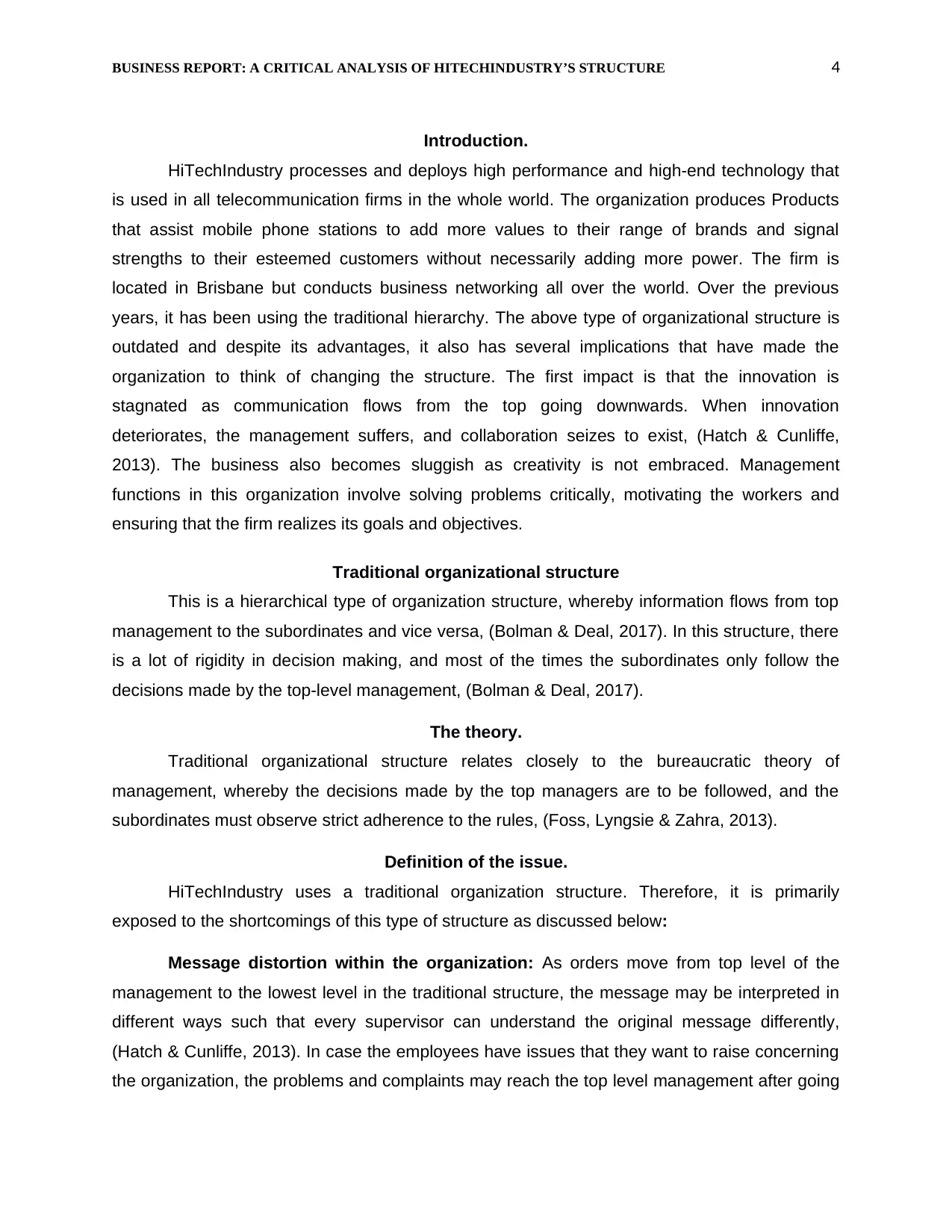
BUSINESS REPORT: A CRITICAL ANALYSIS OF HITECHINDUSTRY’S STRUCTURE 4
Introduction.
HiTechIndustry processes and deploys high performance and high-end technology that
is used in all telecommunication firms in the whole world. The organization produces Products
that assist mobile phone stations to add more values to their range of brands and signal
strengths to their esteemed customers without necessarily adding more power. The firm is
located in Brisbane but conducts business networking all over the world. Over the previous
years, it has been using the traditional hierarchy. The above type of organizational structure is
outdated and despite its advantages, it also has several implications that have made the
organization to think of changing the structure. The first impact is that the innovation is
stagnated as communication flows from the top going downwards. When innovation
deteriorates, the management suffers, and collaboration seizes to exist, (Hatch & Cunliffe,
2013). The business also becomes sluggish as creativity is not embraced. Management
functions in this organization involve solving problems critically, motivating the workers and
ensuring that the firm realizes its goals and objectives.
Traditional organizational structure
This is a hierarchical type of organization structure, whereby information flows from top
management to the subordinates and vice versa, (Bolman & Deal, 2017). In this structure, there
is a lot of rigidity in decision making, and most of the times the subordinates only follow the
decisions made by the top-level management, (Bolman & Deal, 2017).
The theory.
Traditional organizational structure relates closely to the bureaucratic theory of
management, whereby the decisions made by the top managers are to be followed, and the
subordinates must observe strict adherence to the rules, (Foss, Lyngsie & Zahra, 2013).
Definition of the issue.
HiTechIndustry uses a traditional organization structure. Therefore, it is primarily
exposed to the shortcomings of this type of structure as discussed below:
Message distortion within the organization: As orders move from top level of the
management to the lowest level in the traditional structure, the message may be interpreted in
different ways such that every supervisor can understand the original message differently,
(Hatch & Cunliffe, 2013). In case the employees have issues that they want to raise concerning
the organization, the problems and complaints may reach the top level management after going
Introduction.
HiTechIndustry processes and deploys high performance and high-end technology that
is used in all telecommunication firms in the whole world. The organization produces Products
that assist mobile phone stations to add more values to their range of brands and signal
strengths to their esteemed customers without necessarily adding more power. The firm is
located in Brisbane but conducts business networking all over the world. Over the previous
years, it has been using the traditional hierarchy. The above type of organizational structure is
outdated and despite its advantages, it also has several implications that have made the
organization to think of changing the structure. The first impact is that the innovation is
stagnated as communication flows from the top going downwards. When innovation
deteriorates, the management suffers, and collaboration seizes to exist, (Hatch & Cunliffe,
2013). The business also becomes sluggish as creativity is not embraced. Management
functions in this organization involve solving problems critically, motivating the workers and
ensuring that the firm realizes its goals and objectives.
Traditional organizational structure
This is a hierarchical type of organization structure, whereby information flows from top
management to the subordinates and vice versa, (Bolman & Deal, 2017). In this structure, there
is a lot of rigidity in decision making, and most of the times the subordinates only follow the
decisions made by the top-level management, (Bolman & Deal, 2017).
The theory.
Traditional organizational structure relates closely to the bureaucratic theory of
management, whereby the decisions made by the top managers are to be followed, and the
subordinates must observe strict adherence to the rules, (Foss, Lyngsie & Zahra, 2013).
Definition of the issue.
HiTechIndustry uses a traditional organization structure. Therefore, it is primarily
exposed to the shortcomings of this type of structure as discussed below:
Message distortion within the organization: As orders move from top level of the
management to the lowest level in the traditional structure, the message may be interpreted in
different ways such that every supervisor can understand the original message differently,
(Hatch & Cunliffe, 2013). In case the employees have issues that they want to raise concerning
the organization, the problems and complaints may reach the top level management after going
Paraphrase This Document
Need a fresh take? Get an instant paraphrase of this document with our AI Paraphraser
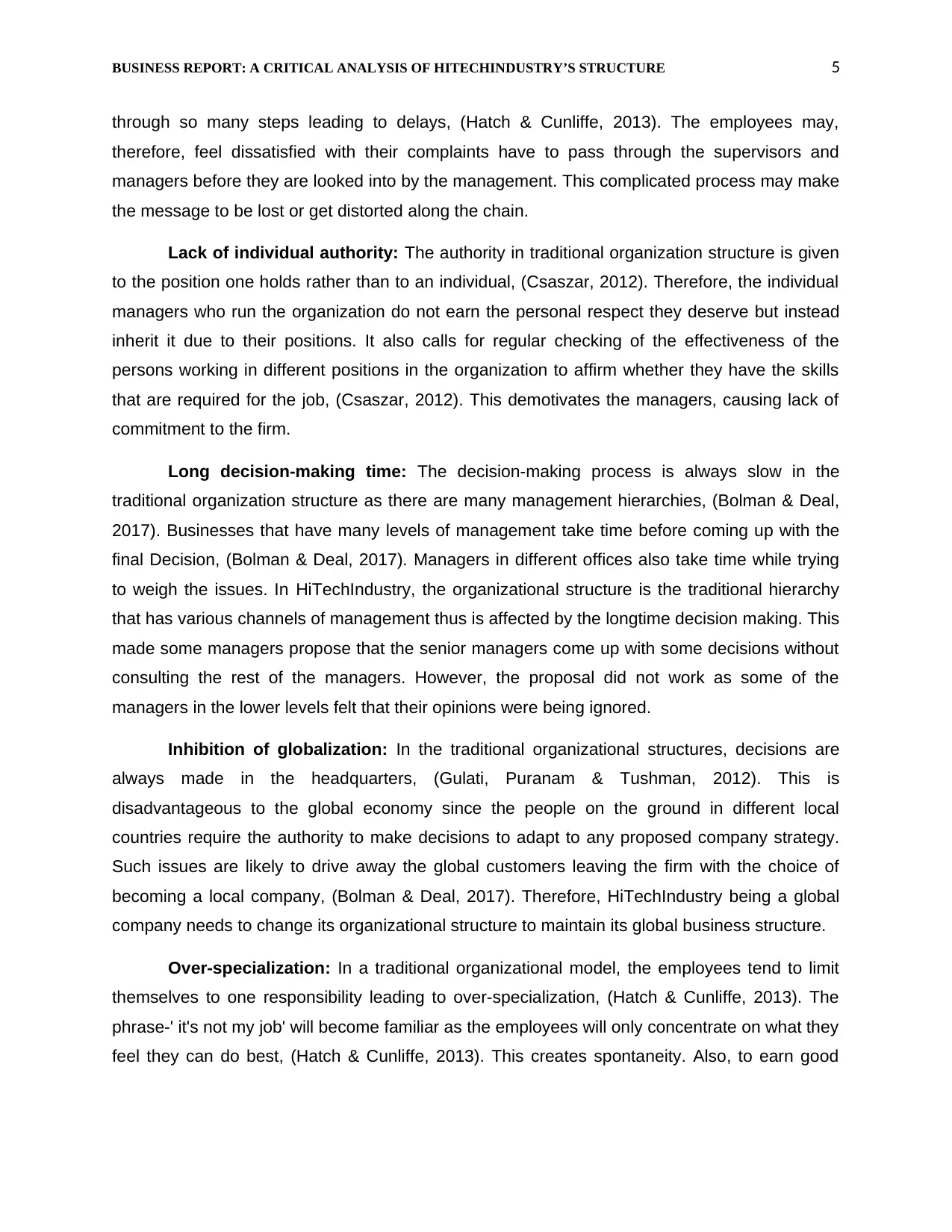
BUSINESS REPORT: A CRITICAL ANALYSIS OF HITECHINDUSTRY’S STRUCTURE 5
through so many steps leading to delays, (Hatch & Cunliffe, 2013). The employees may,
therefore, feel dissatisfied with their complaints have to pass through the supervisors and
managers before they are looked into by the management. This complicated process may make
the message to be lost or get distorted along the chain.
Lack of individual authority: The authority in traditional organization structure is given
to the position one holds rather than to an individual, (Csaszar, 2012). Therefore, the individual
managers who run the organization do not earn the personal respect they deserve but instead
inherit it due to their positions. It also calls for regular checking of the effectiveness of the
persons working in different positions in the organization to affirm whether they have the skills
that are required for the job, (Csaszar, 2012). This demotivates the managers, causing lack of
commitment to the firm.
Long decision-making time: The decision-making process is always slow in the
traditional organization structure as there are many management hierarchies, (Bolman & Deal,
2017). Businesses that have many levels of management take time before coming up with the
final Decision, (Bolman & Deal, 2017). Managers in different offices also take time while trying
to weigh the issues. In HiTechIndustry, the organizational structure is the traditional hierarchy
that has various channels of management thus is affected by the longtime decision making. This
made some managers propose that the senior managers come up with some decisions without
consulting the rest of the managers. However, the proposal did not work as some of the
managers in the lower levels felt that their opinions were being ignored.
Inhibition of globalization: In the traditional organizational structures, decisions are
always made in the headquarters, (Gulati, Puranam & Tushman, 2012). This is
disadvantageous to the global economy since the people on the ground in different local
countries require the authority to make decisions to adapt to any proposed company strategy.
Such issues are likely to drive away the global customers leaving the firm with the choice of
becoming a local company, (Bolman & Deal, 2017). Therefore, HiTechIndustry being a global
company needs to change its organizational structure to maintain its global business structure.
Over-specialization: In a traditional organizational model, the employees tend to limit
themselves to one responsibility leading to over-specialization, (Hatch & Cunliffe, 2013). The
phrase-' it's not my job' will become familiar as the employees will only concentrate on what they
feel they can do best, (Hatch & Cunliffe, 2013). This creates spontaneity. Also, to earn good
through so many steps leading to delays, (Hatch & Cunliffe, 2013). The employees may,
therefore, feel dissatisfied with their complaints have to pass through the supervisors and
managers before they are looked into by the management. This complicated process may make
the message to be lost or get distorted along the chain.
Lack of individual authority: The authority in traditional organization structure is given
to the position one holds rather than to an individual, (Csaszar, 2012). Therefore, the individual
managers who run the organization do not earn the personal respect they deserve but instead
inherit it due to their positions. It also calls for regular checking of the effectiveness of the
persons working in different positions in the organization to affirm whether they have the skills
that are required for the job, (Csaszar, 2012). This demotivates the managers, causing lack of
commitment to the firm.
Long decision-making time: The decision-making process is always slow in the
traditional organization structure as there are many management hierarchies, (Bolman & Deal,
2017). Businesses that have many levels of management take time before coming up with the
final Decision, (Bolman & Deal, 2017). Managers in different offices also take time while trying
to weigh the issues. In HiTechIndustry, the organizational structure is the traditional hierarchy
that has various channels of management thus is affected by the longtime decision making. This
made some managers propose that the senior managers come up with some decisions without
consulting the rest of the managers. However, the proposal did not work as some of the
managers in the lower levels felt that their opinions were being ignored.
Inhibition of globalization: In the traditional organizational structures, decisions are
always made in the headquarters, (Gulati, Puranam & Tushman, 2012). This is
disadvantageous to the global economy since the people on the ground in different local
countries require the authority to make decisions to adapt to any proposed company strategy.
Such issues are likely to drive away the global customers leaving the firm with the choice of
becoming a local company, (Bolman & Deal, 2017). Therefore, HiTechIndustry being a global
company needs to change its organizational structure to maintain its global business structure.
Over-specialization: In a traditional organizational model, the employees tend to limit
themselves to one responsibility leading to over-specialization, (Hatch & Cunliffe, 2013). The
phrase-' it's not my job' will become familiar as the employees will only concentrate on what they
feel they can do best, (Hatch & Cunliffe, 2013). This creates spontaneity. Also, to earn good
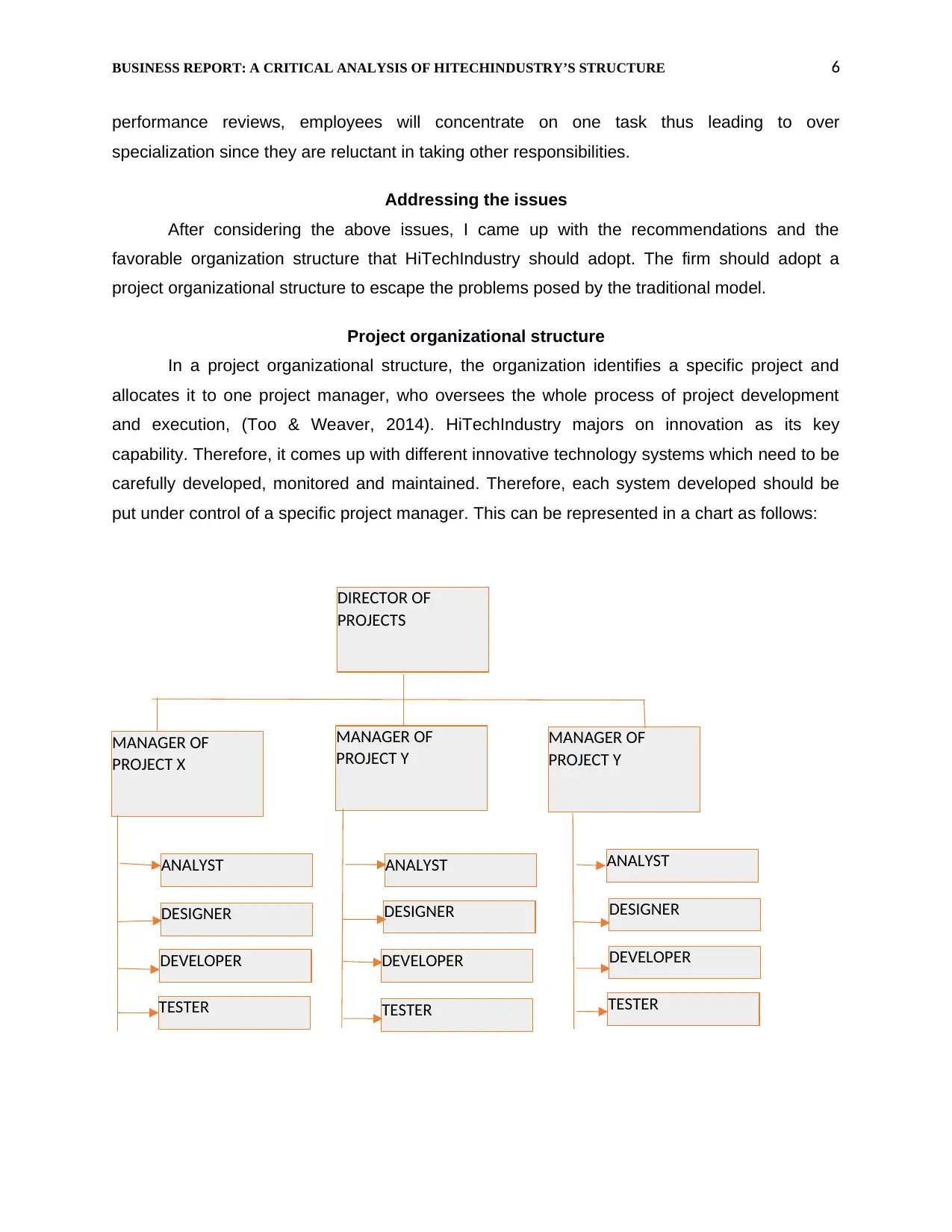
BUSINESS REPORT: A CRITICAL ANALYSIS OF HITECHINDUSTRY’S STRUCTURE 6
performance reviews, employees will concentrate on one task thus leading to over
specialization since they are reluctant in taking other responsibilities.
Addressing the issues
After considering the above issues, I came up with the recommendations and the
favorable organization structure that HiTechIndustry should adopt. The firm should adopt a
project organizational structure to escape the problems posed by the traditional model.
Project organizational structure
In a project organizational structure, the organization identifies a specific project and
allocates it to one project manager, who oversees the whole process of project development
and execution, (Too & Weaver, 2014). HiTechIndustry majors on innovation as its key
capability. Therefore, it comes up with different innovative technology systems which need to be
carefully developed, monitored and maintained. Therefore, each system developed should be
put under control of a specific project manager. This can be represented in a chart as follows:
TESTER
DEVELOPER
DESIGNER
ANALYST
TESTER
DEVELOPER
DESIGNER
ANALYST
TESTER
DEVELOPER
ANALYST
DESIGNER
MANAGER OF
PROJECT Y
MANAGER OF
PROJECT Y
MANAGER OF
PROJECT X
DIRECTOR OF
PROJECTS
performance reviews, employees will concentrate on one task thus leading to over
specialization since they are reluctant in taking other responsibilities.
Addressing the issues
After considering the above issues, I came up with the recommendations and the
favorable organization structure that HiTechIndustry should adopt. The firm should adopt a
project organizational structure to escape the problems posed by the traditional model.
Project organizational structure
In a project organizational structure, the organization identifies a specific project and
allocates it to one project manager, who oversees the whole process of project development
and execution, (Too & Weaver, 2014). HiTechIndustry majors on innovation as its key
capability. Therefore, it comes up with different innovative technology systems which need to be
carefully developed, monitored and maintained. Therefore, each system developed should be
put under control of a specific project manager. This can be represented in a chart as follows:
TESTER
DEVELOPER
DESIGNER
ANALYST
TESTER
DEVELOPER
DESIGNER
ANALYST
TESTER
DEVELOPER
ANALYST
DESIGNER
MANAGER OF
PROJECT Y
MANAGER OF
PROJECT Y
MANAGER OF
PROJECT X
DIRECTOR OF
PROJECTS
⊘ This is a preview!⊘
Do you want full access?
Subscribe today to unlock all pages.

Trusted by 1+ million students worldwide
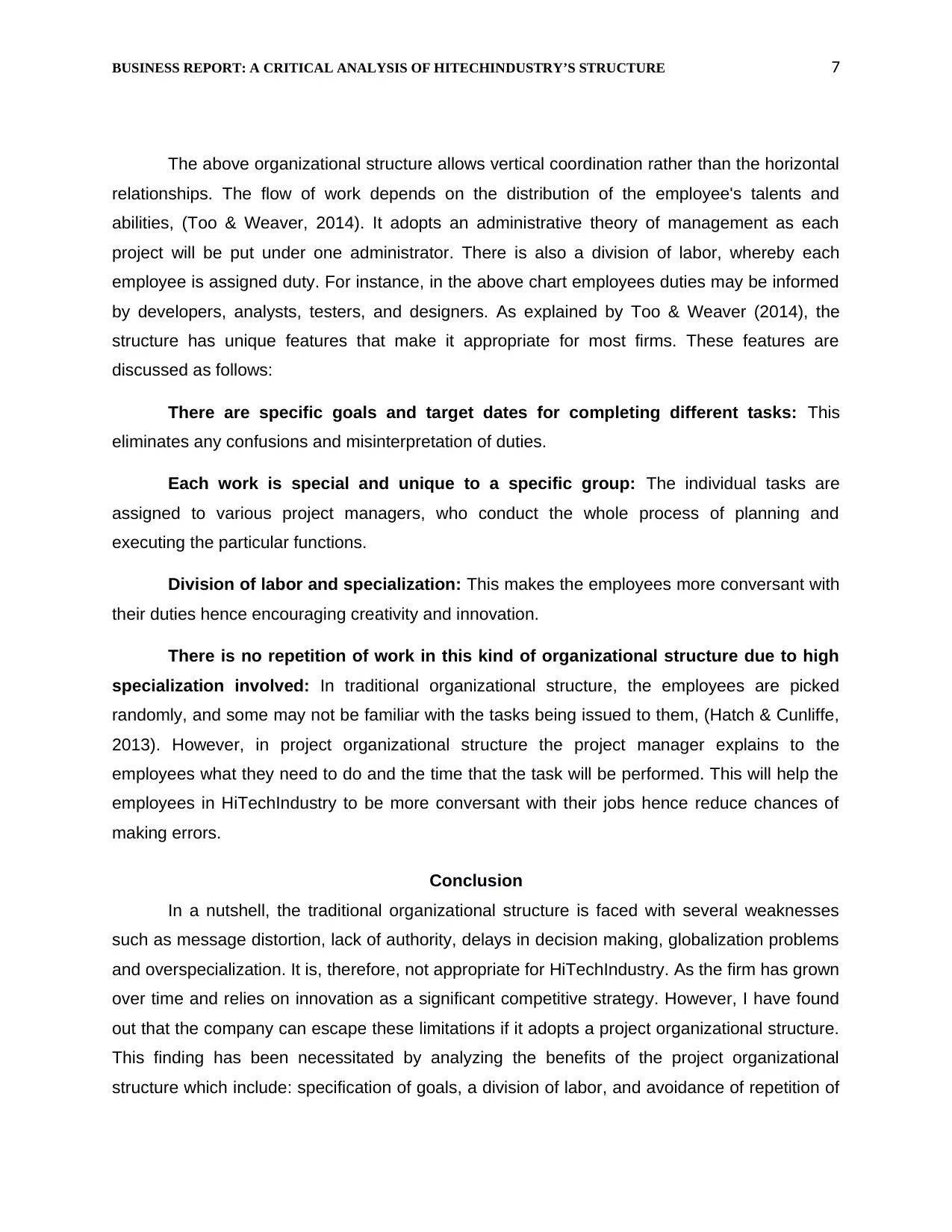
BUSINESS REPORT: A CRITICAL ANALYSIS OF HITECHINDUSTRY’S STRUCTURE 7
The above organizational structure allows vertical coordination rather than the horizontal
relationships. The flow of work depends on the distribution of the employee's talents and
abilities, (Too & Weaver, 2014). It adopts an administrative theory of management as each
project will be put under one administrator. There is also a division of labor, whereby each
employee is assigned duty. For instance, in the above chart employees duties may be informed
by developers, analysts, testers, and designers. As explained by Too & Weaver (2014), the
structure has unique features that make it appropriate for most firms. These features are
discussed as follows:
There are specific goals and target dates for completing different tasks: This
eliminates any confusions and misinterpretation of duties.
Each work is special and unique to a specific group: The individual tasks are
assigned to various project managers, who conduct the whole process of planning and
executing the particular functions.
Division of labor and specialization: This makes the employees more conversant with
their duties hence encouraging creativity and innovation.
There is no repetition of work in this kind of organizational structure due to high
specialization involved: In traditional organizational structure, the employees are picked
randomly, and some may not be familiar with the tasks being issued to them, (Hatch & Cunliffe,
2013). However, in project organizational structure the project manager explains to the
employees what they need to do and the time that the task will be performed. This will help the
employees in HiTechIndustry to be more conversant with their jobs hence reduce chances of
making errors.
Conclusion
In a nutshell, the traditional organizational structure is faced with several weaknesses
such as message distortion, lack of authority, delays in decision making, globalization problems
and overspecialization. It is, therefore, not appropriate for HiTechIndustry. As the firm has grown
over time and relies on innovation as a significant competitive strategy. However, I have found
out that the company can escape these limitations if it adopts a project organizational structure.
This finding has been necessitated by analyzing the benefits of the project organizational
structure which include: specification of goals, a division of labor, and avoidance of repetition of
The above organizational structure allows vertical coordination rather than the horizontal
relationships. The flow of work depends on the distribution of the employee's talents and
abilities, (Too & Weaver, 2014). It adopts an administrative theory of management as each
project will be put under one administrator. There is also a division of labor, whereby each
employee is assigned duty. For instance, in the above chart employees duties may be informed
by developers, analysts, testers, and designers. As explained by Too & Weaver (2014), the
structure has unique features that make it appropriate for most firms. These features are
discussed as follows:
There are specific goals and target dates for completing different tasks: This
eliminates any confusions and misinterpretation of duties.
Each work is special and unique to a specific group: The individual tasks are
assigned to various project managers, who conduct the whole process of planning and
executing the particular functions.
Division of labor and specialization: This makes the employees more conversant with
their duties hence encouraging creativity and innovation.
There is no repetition of work in this kind of organizational structure due to high
specialization involved: In traditional organizational structure, the employees are picked
randomly, and some may not be familiar with the tasks being issued to them, (Hatch & Cunliffe,
2013). However, in project organizational structure the project manager explains to the
employees what they need to do and the time that the task will be performed. This will help the
employees in HiTechIndustry to be more conversant with their jobs hence reduce chances of
making errors.
Conclusion
In a nutshell, the traditional organizational structure is faced with several weaknesses
such as message distortion, lack of authority, delays in decision making, globalization problems
and overspecialization. It is, therefore, not appropriate for HiTechIndustry. As the firm has grown
over time and relies on innovation as a significant competitive strategy. However, I have found
out that the company can escape these limitations if it adopts a project organizational structure.
This finding has been necessitated by analyzing the benefits of the project organizational
structure which include: specification of goals, a division of labor, and avoidance of repetition of
Paraphrase This Document
Need a fresh take? Get an instant paraphrase of this document with our AI Paraphraser
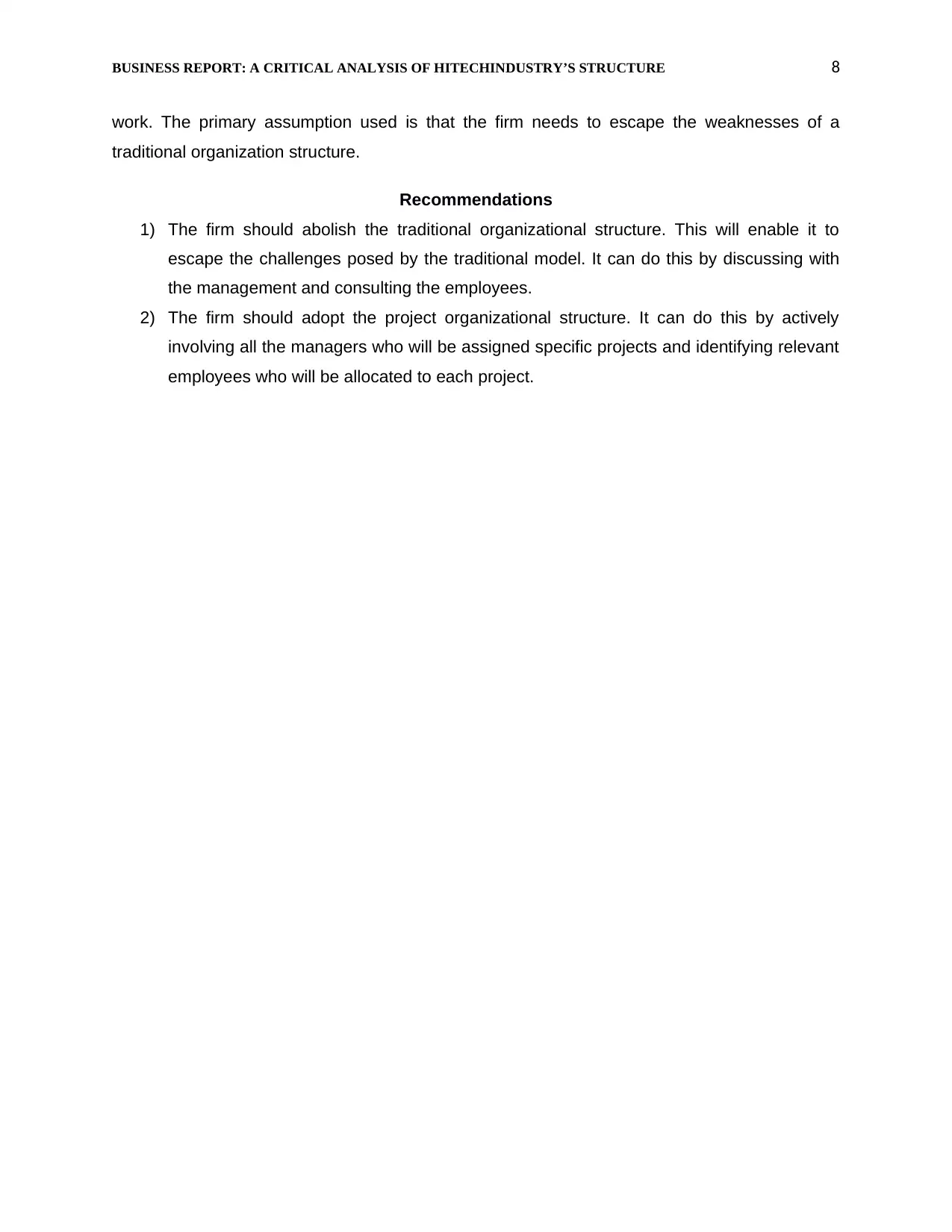
BUSINESS REPORT: A CRITICAL ANALYSIS OF HITECHINDUSTRY’S STRUCTURE 8
work. The primary assumption used is that the firm needs to escape the weaknesses of a
traditional organization structure.
Recommendations
1) The firm should abolish the traditional organizational structure. This will enable it to
escape the challenges posed by the traditional model. It can do this by discussing with
the management and consulting the employees.
2) The firm should adopt the project organizational structure. It can do this by actively
involving all the managers who will be assigned specific projects and identifying relevant
employees who will be allocated to each project.
work. The primary assumption used is that the firm needs to escape the weaknesses of a
traditional organization structure.
Recommendations
1) The firm should abolish the traditional organizational structure. This will enable it to
escape the challenges posed by the traditional model. It can do this by discussing with
the management and consulting the employees.
2) The firm should adopt the project organizational structure. It can do this by actively
involving all the managers who will be assigned specific projects and identifying relevant
employees who will be allocated to each project.
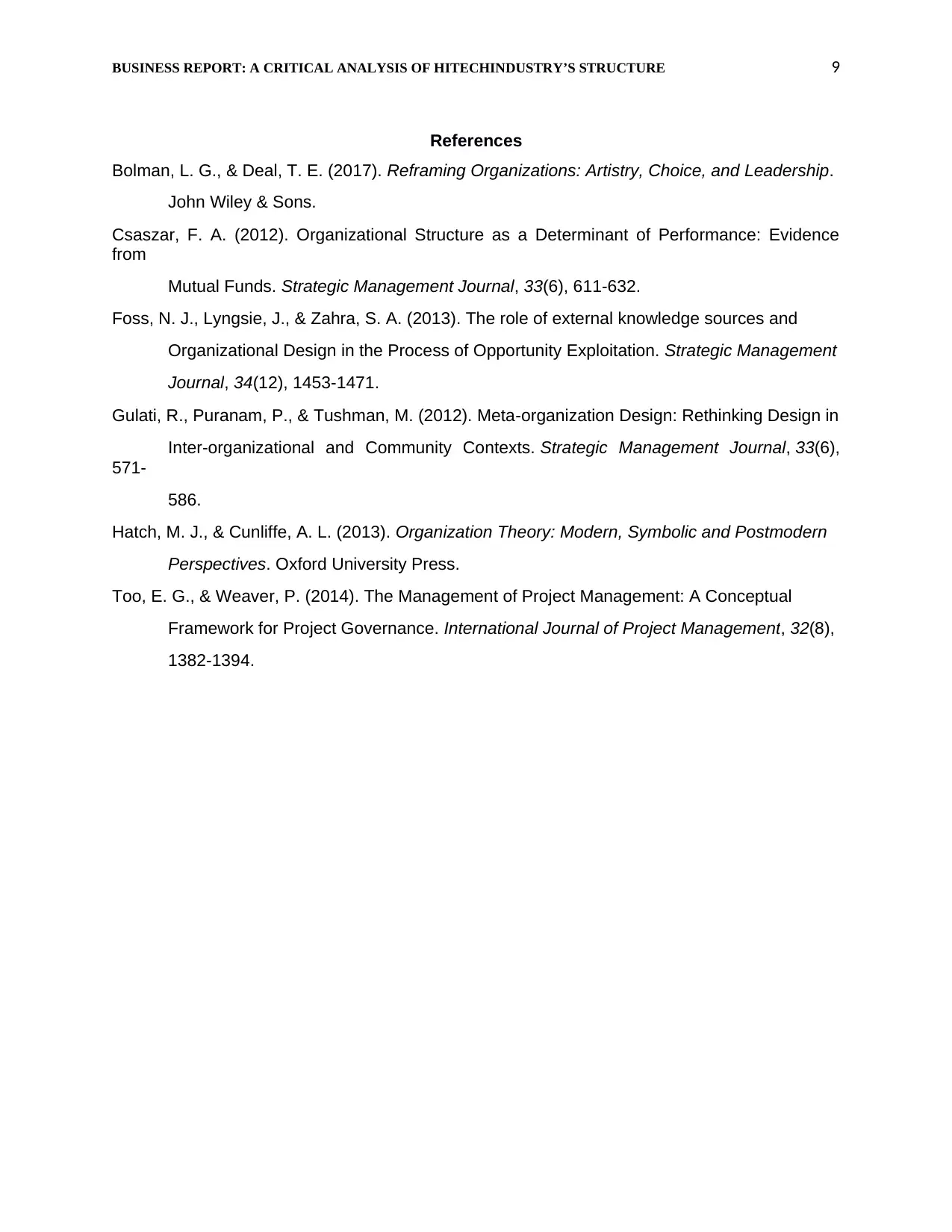
BUSINESS REPORT: A CRITICAL ANALYSIS OF HITECHINDUSTRY’S STRUCTURE 9
References
Bolman, L. G., & Deal, T. E. (2017). Reframing Organizations: Artistry, Choice, and Leadership.
John Wiley & Sons.
Csaszar, F. A. (2012). Organizational Structure as a Determinant of Performance: Evidence
from
Mutual Funds. Strategic Management Journal, 33(6), 611-632.
Foss, N. J., Lyngsie, J., & Zahra, S. A. (2013). The role of external knowledge sources and
Organizational Design in the Process of Opportunity Exploitation. Strategic Management
Journal, 34(12), 1453-1471.
Gulati, R., Puranam, P., & Tushman, M. (2012). Meta‐organization Design: Rethinking Design in
Inter-organizational and Community Contexts. Strategic Management Journal, 33(6),
571-
586.
Hatch, M. J., & Cunliffe, A. L. (2013). Organization Theory: Modern, Symbolic and Postmodern
Perspectives. Oxford University Press.
Too, E. G., & Weaver, P. (2014). The Management of Project Management: A Conceptual
Framework for Project Governance. International Journal of Project Management, 32(8),
1382-1394.
References
Bolman, L. G., & Deal, T. E. (2017). Reframing Organizations: Artistry, Choice, and Leadership.
John Wiley & Sons.
Csaszar, F. A. (2012). Organizational Structure as a Determinant of Performance: Evidence
from
Mutual Funds. Strategic Management Journal, 33(6), 611-632.
Foss, N. J., Lyngsie, J., & Zahra, S. A. (2013). The role of external knowledge sources and
Organizational Design in the Process of Opportunity Exploitation. Strategic Management
Journal, 34(12), 1453-1471.
Gulati, R., Puranam, P., & Tushman, M. (2012). Meta‐organization Design: Rethinking Design in
Inter-organizational and Community Contexts. Strategic Management Journal, 33(6),
571-
586.
Hatch, M. J., & Cunliffe, A. L. (2013). Organization Theory: Modern, Symbolic and Postmodern
Perspectives. Oxford University Press.
Too, E. G., & Weaver, P. (2014). The Management of Project Management: A Conceptual
Framework for Project Governance. International Journal of Project Management, 32(8),
1382-1394.
⊘ This is a preview!⊘
Do you want full access?
Subscribe today to unlock all pages.

Trusted by 1+ million students worldwide
1 out of 9
Related Documents
Your All-in-One AI-Powered Toolkit for Academic Success.
+13062052269
info@desklib.com
Available 24*7 on WhatsApp / Email
![[object Object]](/_next/static/media/star-bottom.7253800d.svg)
Unlock your academic potential
Copyright © 2020–2025 A2Z Services. All Rights Reserved. Developed and managed by ZUCOL.





